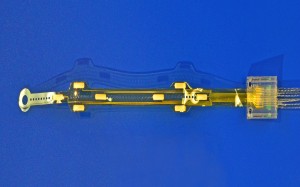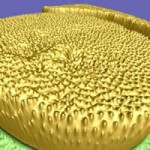The Brain research, ethics, and nanotechnology (part one of five) May 19, 2014 post kicked off a series titled ‘Brains, prostheses, nanotechnology, and human enhancement’ which brings together a number of developments in the worlds of neuroscience, prosthetics, and, incidentally, nanotechnology in the field of interest called human enhancement. Parts one through four are an attempt to draw together a number of new developments, mostly in the US and in Europe. Due to my language skills which extend to English and, more tenuously, French, I can’t provide a more ‘global perspective’.
Now for the summary. Ranging from research meant to divulge more about how the brain operates in hopes of healing conditions such as Parkinson’s and Alzeheimer’s diseases to utilizing public engagement exercises (first developed for nanotechnology) for public education and acceptance of brain research to the development of prostheses for the nervous system such as the Walk Again robotic suit for individuals with paraplegia (and, I expect quadriplegia [aka tetraplegia] in the future), brain research is huge in terms of its impact socially and economically across the globe.
Until now, I have not included information about neuromorphic engineering (creating computers with the processing capabilities of human brains). My May 16, 2014 posting (Wacky oxide. biological synchronicity, and human brainlike computing) features one of the latest developments along with this paragraph providing links to overview materials of the field,
As noted earlier, there are other approaches to creating an artificial brain, i.e., neuromorphic engineering. My April 7, 2014 posting is the most recent synopsis posted here; it includes excerpts from a Nanowerk Spotlight article overview along with a mention of the ‘brain jelly’ approach and a discussion of my somewhat extensive coverage of memristors and a mention of work on nanoionic devices. There is also a published roadmap to neuromorphic engineering featuring both analog and digital devices, mentioned in my April 18, 2014 posting.
There is an international brain (artificial and organic) enterprise underway. Meanwhile, work understanding the brain will lead to new therapies and, inevitably, attempts to enhance intelligence. There are already drugs and magic potions (e.g. oxygenated water in Mental clarity, stamina, endurance — is it in the bottle? Celebrity athletes tout the benefits of oxygenated water, but scientists have their doubts, a May 16,2014 article by Pamela Fayerman for the Vancouver Sun). In a June 19, 2009 posting featured Jamais Cascio’s speculations about augmenting intelligence in an Atlantic magazine article.
While researchers such Miguel Nicolelis work on exoskeletons (externally worn robotic suits) controlled by the wearer’s thoughts and giving individuals with paraplegia the ability to walk, researchers from one of Germany’s Fraunhofer Institutes reveal a different technology for achieving the same ends. From a May 16, 2014 news item on Nanowerk,
People with severe injuries to their spinal cord currently have no prospect of recovery and remain confined to their wheelchairs. Now, all that could change with a new treatment that stimulates the spinal cord using electric impulses. The hope is that the technique will help paraplegic patients learn to walk again. From June 3 – 5 [2-14], Fraunhofer researchers will be at the Sensor + Test measurement fair in Nürnberg to showcase the implantable microelectrode sensors they have developed in the course of pre-clinical development work (Hall 12, Booth 12-537).
A May 14, 2014 Fraunhofer Institute news release, which originated the news item, provides more details about this technology along with an image of the implantable microelectrode sensors,
Now a consortium of European research institutions and companies want to get affected patients quite literally back on their feet. In the EU’s [European Union’s] NEUWalk project, which has been awarded funding of some nine million euros, researchers are working on a new method of treatment designed to restore motor function in patients who have suffered severe injuries to their spinal cord. The technique relies on electrically stimulating the nerve pathways in the spinal cord. “In the injured area, the nerve cells have been damaged to such an extent that they no longer receive usable information from the brain, so the stimulation needs to be delivered beneath that,” explains Dr. Peter Detemple, head of department at the Fraunhofer Institute for Chemical Technology’s Mainz branch (IMM) and NEUWalk project coordinator. To do this, Detemple and his team are developing flexible, wafer-thin microelectrodes that are implanted within the spinal canal on the spinal cord. These multichannel electrode arrays stimulate the nerve pathways with electric impulses that are generated by the accompanying by microprocessor-controlled neurostimulator. “The various electrodes of the array are located around the nerve roots responsible for locomotion. By delivering a series of pulses, we can trigger those nerve roots in the correct order to provoke motion sequences of movements and support the motor function,” says Detemple.
Researchers from the consortium have already successfully conducted tests on rats in which the spinal cord had not been completely severed. As well as stimulating the spinal cord, the rats were given a combination of medicine and rehabilitation training. Afterwards the animals were able not only to walk but also to run, climb stairs and surmount obstacles. “We were able to trigger specific movements by delivering certain sequences of pulses to the various electrodes implanted on the spinal cord,” says Detemple. The research scientist and his team believe that the same approach could help people to walk again, too. “We hope that we will be able to transfer the results of our animal testing to people. Of course, people who have suffered injuries to their spinal cord will still be limited when it comes to sport or walking long distances. The first priority is to give them a certain level of independence so that they can move around their apartment and look after themselves, for instance, or walk for short distances without requiring assistance,” says Detemple.
Researchers from the NEUWalk project intend to try out their system on two patients this summer. In this case, the patients are not completely paraplegic, which means there is still some limited communication between the brain and the legs. The scientists are currently working on tailored implants for the intervention. “However, even if both trials are a success, it will still be a few years before the system is ready for the general market. First, the method has to undergo clinical studies and demonstrate its effectiveness among a wider group of patients,” says Detemple.
…
Patients with Parkinson’s disease could also benefit from the neural prostheses. The most well-known symptoms of the disease are trembling, extreme muscle tremors and a short, [emphasis mine] stooped gait that has a profound effect on patients’ mobility. Until now this neurodegenerative disorder has mostly been treated with dopamine agonists – drugs that chemically imitate the effects of dopamine but that often lead to severe side effects when taken over a longer period of time. Once the disease has reached an advanced stage, doctors often turn to deep brain stimulation. This involves a complex operation to implant electrodes in specific parts of the brain so that the nerve cells in the region can be stimulated or suppressed as required. In the NEUWalk project, researchers are working on electric spinal cord simulation – an altogether less dangerous intervention that should however ease the symptoms of Parkinson’s disease just as effectively. “Initial animal testing has yielded some very promising results,” says Detemple.
(For anyone interested in the NEUWalk project, you can find more here,) Note the reference to Parkinson’s in the context of work designed for people with paraplegia. Brain research and prosthetics (specifically neuroprosthetics or neural prosthetics), are interconnected. As for the nanotechnology connection, in its role as an enabling technology it has provided some of the tools that make these efforts possible. It has also made some of the work in neuromorphic engineering (attempts to create an artificial brain that mimics the human brain) possible. It is a given that research on the human brain will inform efforts in neuromorphic engineering and that attempts will be made to create prostheses for the brain (cyborg brain) and other enhancements.
One final comment, I’m not so sure that transferring approaches and techniques developed to gain public acceptance of nanotechnology are necessarily going to be effective. (Harthorn seemed to be suggesting in her presentation to the Presidential Presidential Commission for the Study of Bioethical Issues that these ‘nano’ approaches could be adopted. Other researchers [Caulfield with the genome and Racine with previous neuroscience efforts] also suggested their experience could be transferred. While some of that is likely true,, it should be noted that some self-interest may be involved as brain research is likely to be a fresh source of funding for social science researchers with experience in nanotechnology and genomics who may be finding their usual funding sources less generous than previously.)
The likelihood there will be a substantive public panic over brain research is higher than it ever was for a nanotechnology panic (I am speaking with the benefit of hindsight re: nano panics). Everyone understands the word, ‘brain’, far fewer understand the word ‘nanotechnology’ which means that the level of interest is lower and people are less likely to get disturbed by an obscure technology. (The GMO panic gained serious traction with the ‘Frankenfood’ branding and when it fused rather unexpectedly with another research story, stem cell research. In the UK, one can also add the panic over ‘mad cow’ disease or Creutzfeldt-Jakob disease (CJD), as it’s also known, to the mix. It was the GMO and other assorted panics which provided the impetus for much of the public engagement funding for nanotechnology.)
All one has to do in this instance is start discussions about changing someone’s brain and cyborgs and these researchers may find they have a much more volatile situation on their hands. As well, everyone (the general public and civil society groups/activists, not just the social science and science researchers) involved in the nanotechnology public engagement exercises has learned from the experience. In the meantime, pop culture concerns itself with zombies and we all know what they like to eat.
Links to other posts in the Brains, prostheses, nanotechnology, and human enhancement five-part series
Part one: Brain research, ethics, and nanotechnology (May 19, 2014 post)
Part two: BRAIN and ethics in the US with some Canucks (not the hockey team) participating (May 19, 2014)
Part three: Gray Matters: Integrative Approaches for Neuroscience, Ethics, and Society issued May 2014 by US Presidential Bioethics Commission (May 20, 2014)
Part four: Brazil, the 2014 World Cup kickoff, and a mind-controlled exoskeleton (May 20, 2014)

